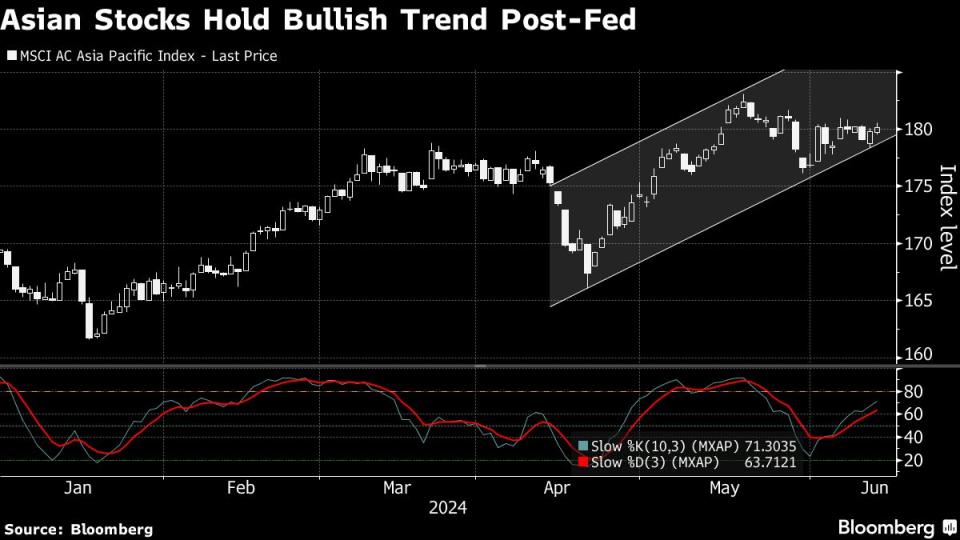Here’s What to Watch in Asian Markets After Fed Decision, CPI
(Bloomberg) -- Asian stocks and currencies fluctuated on Thursday as investors parsed the double-whammy of a Federal Reserve rate decision and US consumer price data.
Most Read from Bloomberg
Apple to ‘Pay’ OpenAI for ChatGPT Through Distribution, Not Cash
Hunter Biden Was Convicted. His Dad’s Reaction Was Remarkable.
US Producer Prices Surprise With Biggest Decline Since October
Gavin Newsom Wants to Curb a Labor Law That Cost Businesses $10 Billion
Chinese Trader’s $20 Million Pile of Russian Copper Goes Missing
Equities and dollar-denominated bonds are seen benefiting, even if the bullish inflation reading was tempered by Fed officials pulling back their rate cut forecasts for the year, according to strategists. Currencies like the rupiah and won are expected to outperform, they said, though some warned that the chance of a stronger dollar hadn’t gone away.
The decision was “broadly supportive for risk assets given the nice inflation surprise and lower rates. The dot plot reversed some of the bond rally as the market digested the removal of a rate cut in 2024,” said Matthew Haupt, a portfolio manager at Wilson Asset Management. “Potentially lower US rates and a lower dollar should be supportive of risk assets.”
Here are some views from market participants:
Currency Strength...
“I think Asia can perform well,” with currencies like the Indonesian rupiah and South Korean won outperforming in a risk-on type environment, said Brendan McKenna, emerging markets economist and strategist at Wells Fargo in New York. “Most of the EM currencies that underperformed had a local story that spooked markets. For the time being, the idiosyncratic stories impacting some Latam FX aren’t as present in Asia, so general risk sentiment supports regional FX.”
“A softer dollar puts considerably less pressure on Asian currencies, which have come under pressure from the strong dollar,” said Quincy Krosby, chief global strategist for LPL Financial. “Also, commodity imports, particularly crude oil, are less of a burden.” “There’s a sense markets are comfortable assuming inflation will continue to ease enough for the Fed to begin cutting rates in September.”
...or Not
“Asian currencies are likely to remain under pressure,” said Win Thin, global head of markets strategy at Brown Brothers Harriman & Co. in New York. “The strong dollar narrative remains in play despite the good CPI data.”
Attractive Bonds
“Asian bonds continue to be attractive diversifiers for global portfolios, as local yields remain higher than they otherwise might be (relative to inflation), with currencies that are quite stable,” BlackRock Inc. APAC Fixed Income CIO Neeraj Seth and Head of Asia Macro for Fundamental Fixed Income Navin Saigal wrote in a note.
Modestly Positive
“The net impact of CPI plus Fed was positive, just less positive than if it was just CPI, so I wouldn’t expect a really negative impact” in Asia, said Shamaila Khan, head of fixed income for emerging markets and Asia Pacific at UBS Asset Management. “The Asia local markets tend to be not the high carry ones” and aren’t as volatile on day-to-day moves as the rest of the emerging market landscape, she said. “Generally speaking, they’ll all be in a range.”
Risk-On
“The net impact of the two events, FOMC and CPI, would be positive for Asian central banks,” said Tomo Kinoshita, a global markets strategist at Invesco Asset Management. The results are likely to lead to stronger Asian currencies against the dollar and higher stock prices. Meanwhile, lower US yields are expected to be a positive factor for Asian growth stocks.
“The ‘turning-point-potential’ CPI report prompts investors to adopt a glass-half-full view,” said Hebe Chen, an analyst at IG Markets. “With at least five rate cuts remaining firmly on the table over the next 18 months, continuing the current upward journey of risk equities seems fairly justified.”
Hesitation
“Wall Street has a tendency to see what it wants, and I can’t say I’m seeing the same bullish enthusiasm” in Asia, said Matt Simpson, a senior market strategist at City Index Inc. “I’d have expected a stronger follow-through from Nikkei futures overnight given the Nasdaq’s surge to its latest record high, yet with the May high looming and the yen holding ground, it seems upside potential for the Nikkei could be relatively limited.” Moves in China equity futures also lacked conviction, he added.
Stronger Yen
“The CPI is a welcome sign for those who expect a rate cut,” said Makoto Yamashita, chief economist at Shinkumi Federation Bank. “The yen will appreciate against the dollar.”
Higher Aussie
The Aussie unwound some of its post-CPI gain and may be weighed further should Australia’s unemployment rate remain high later today, said Kristina Clifton, senior economist and currency strategist at Commonwealth Bank of Australia in Sydney. “However, we consider the next big move is up because of undervaluation, low volatility, and rate cuts that will improve the global economic outlook.”
Tight Credit Spreads
“Although credit spreads are tight by historical standards, last night’s benign US CPI and the Fed’s ongoing commitment to future rate cuts — even if pushed into 2025 — should drive continued demand for dollar investment-grade bonds due to their attractive all-in yield,” said Mark Reade, head of credit strategy at Mizuho Securities Asia. “Combined with satisfactory corporate fundamentals and scarce regional supply, that’s likely to keep Asian USD credit spreads tight for at least a few more months.”
--With assistance from Michael G. Wilson, Finbarr Flynn, Ruth Carson, Georgina McKay, Daisuke Sakai, Hidenori Yamanaka and Yui Hasebe.
Most Read from Bloomberg Businessweek
Israeli Scientists Are Shunned by Universities Over the Gaza War
The World’s Most Online Male Gymnast Prepares for the Paris Olympics
Grieving Families Blame Panera’s Charged Lemonade for Leaving a Deadly Legacy
China’s Economic Powerhouse Is Feeling the Brunt of Its Slowdown
©2024 Bloomberg L.P.

 Yahoo Finance
Yahoo Finance 

